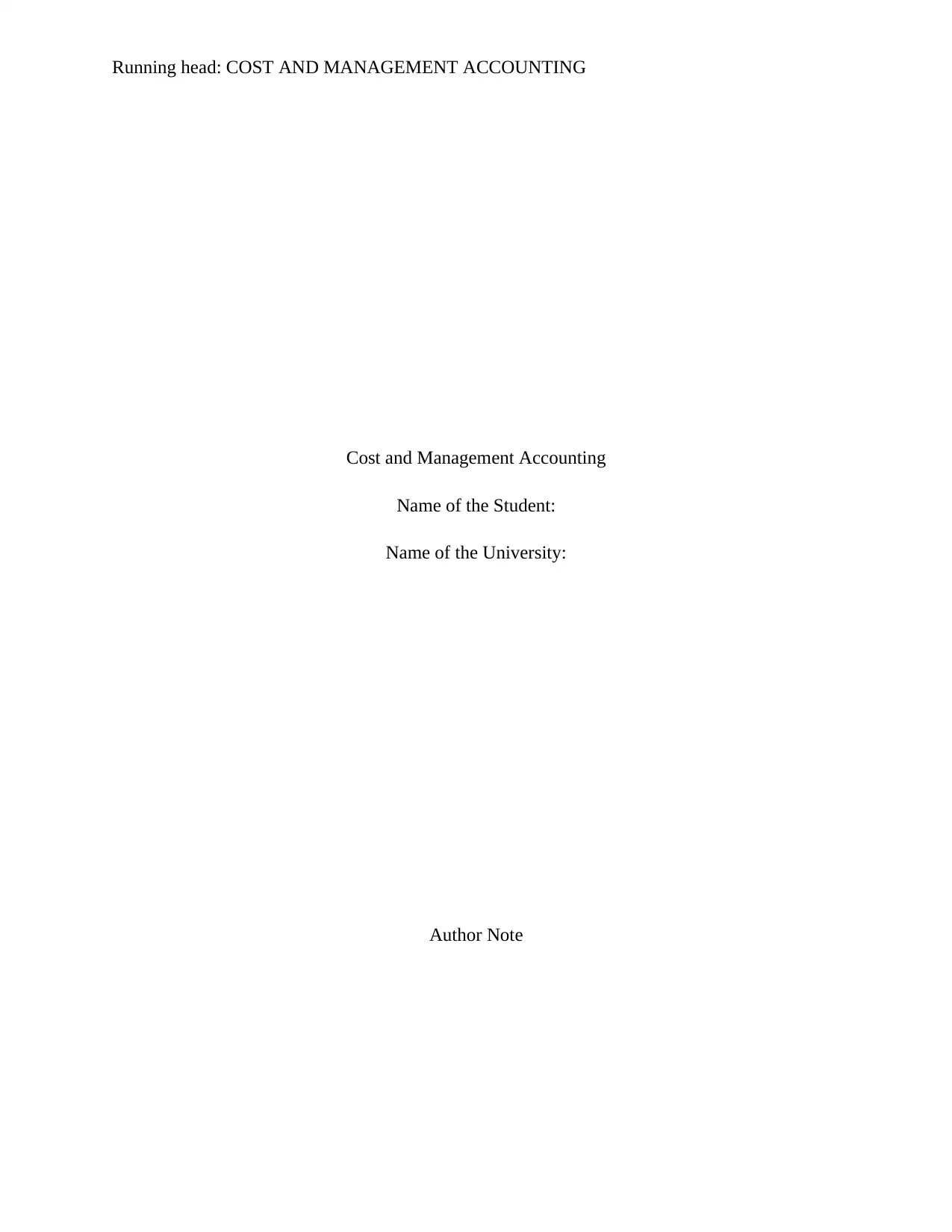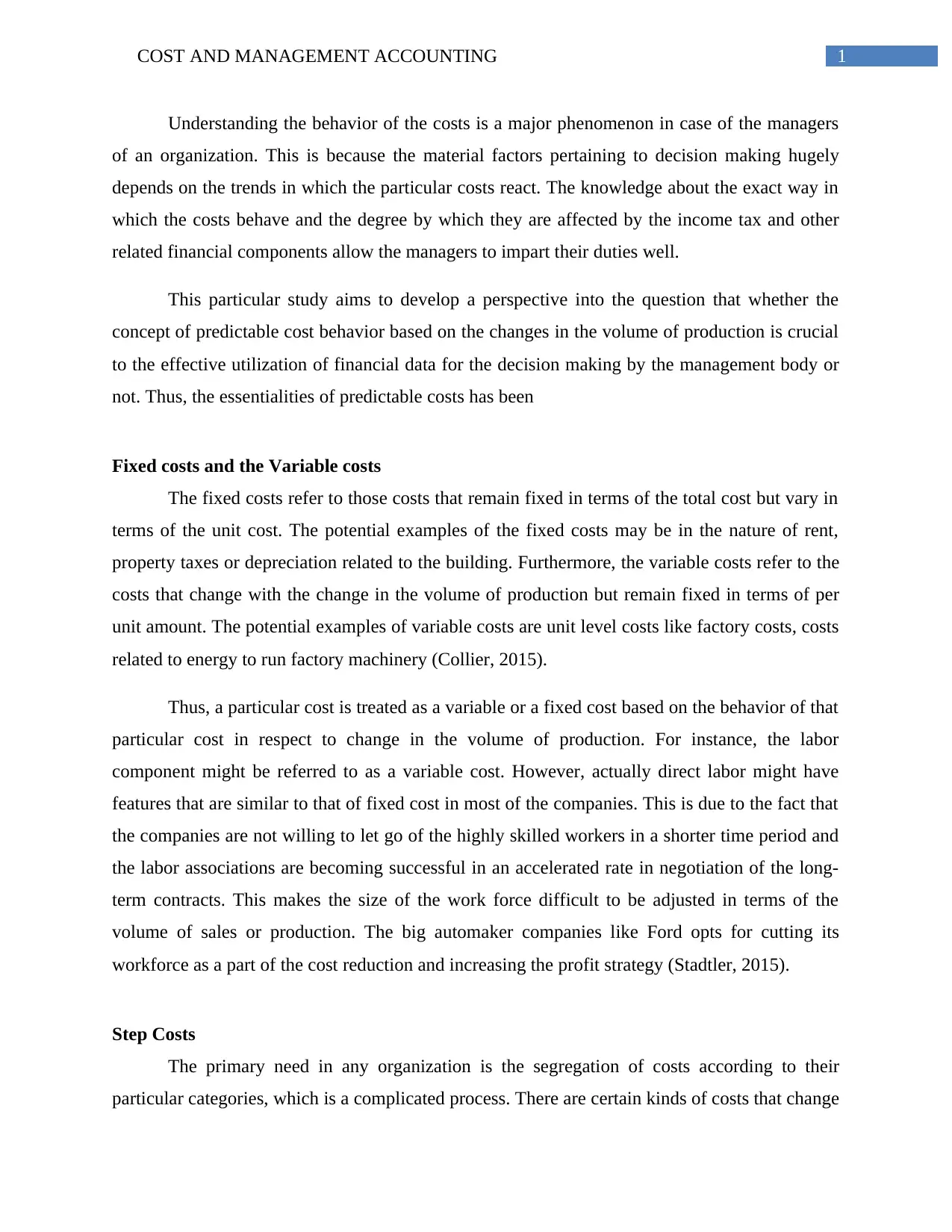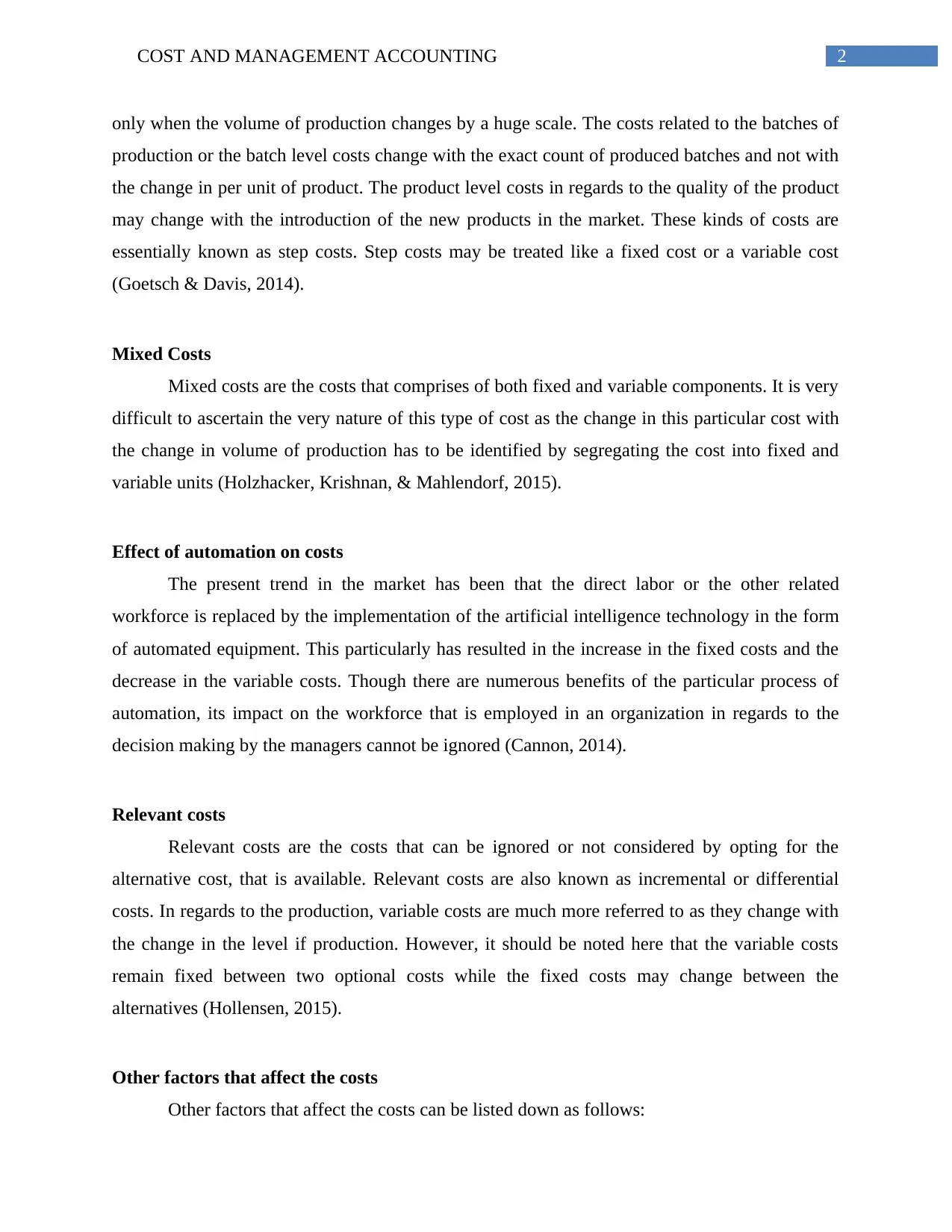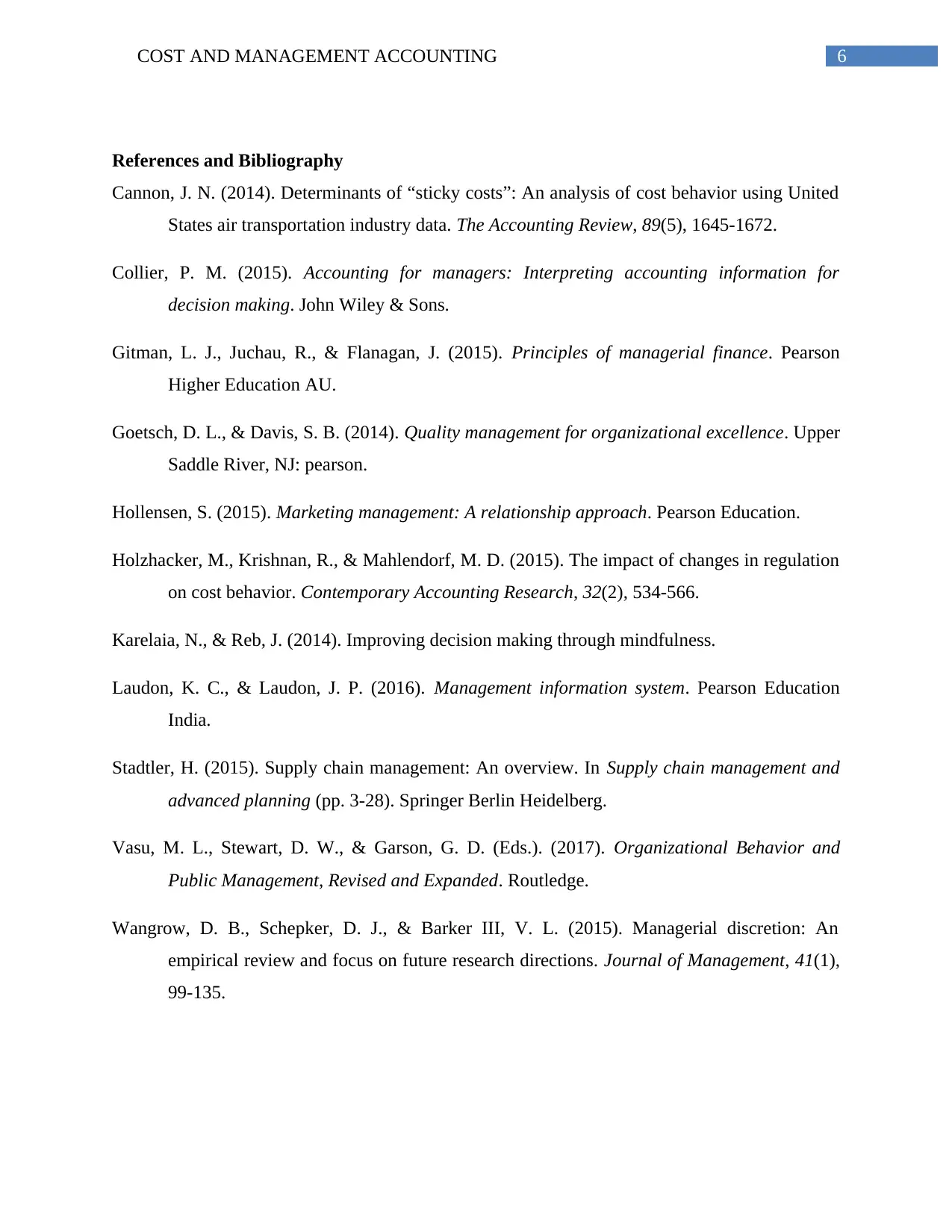Analyzing Cost Behavior and Managerial Decision Making
VerifiedAdded on 2020/05/28
|7
|2035
|151
Essay
AI Summary
The assignment explores the intricate dynamics of cost behavior in relation to changes in the volume of production, emphasizing its critical role in managerial decision-making. By examining a range of costs such as variable, fixed, semi-variable, committed, discretionary, sunk, opportunity, external, and internal costs, it provides insights into how these elements influence business strategies and operations. The analysis further delves into cost behavior patterns including linearity, step-fixed, curvilinear, mixed, learning effects, capacity constraints, and managerial control over costs, highlighting their implications for strategic planning and decision-making processes within organizations. Through an exploration of theoretical perspectives and practical applications in industries like manufacturing and service sectors, the assignment underscores the necessity for managers to grasp cost trends, facilitating informed decisions on pricing, production levels, and investment strategies. By integrating accounting principles with managerial insights, it offers a comprehensive understanding of how cost information, when effectively analyzed and applied, can drive organizational efficiency, competitiveness, and growth. The discussion is enriched by referencing key studies and literature in the field, providing a solid foundation for appreciating the multifaceted relationship between cost behavior and management practices.

Running head: COST AND MANAGEMENT ACCOUNTING
Cost and Management Accounting
Name of the Student:
Name of the University:
Author Note
Cost and Management Accounting
Name of the Student:
Name of the University:
Author Note
Paraphrase This Document
Need a fresh take? Get an instant paraphrase of this document with our AI Paraphraser

1COST AND MANAGEMENT ACCOUNTING
Understanding the behavior of the costs is a major phenomenon in case of the managers
of an organization. This is because the material factors pertaining to decision making hugely
depends on the trends in which the particular costs react. The knowledge about the exact way in
which the costs behave and the degree by which they are affected by the income tax and other
related financial components allow the managers to impart their duties well.
This particular study aims to develop a perspective into the question that whether the
concept of predictable cost behavior based on the changes in the volume of production is crucial
to the effective utilization of financial data for the decision making by the management body or
not. Thus, the essentialities of predictable costs has been
Fixed costs and the Variable costs
The fixed costs refer to those costs that remain fixed in terms of the total cost but vary in
terms of the unit cost. The potential examples of the fixed costs may be in the nature of rent,
property taxes or depreciation related to the building. Furthermore, the variable costs refer to the
costs that change with the change in the volume of production but remain fixed in terms of per
unit amount. The potential examples of variable costs are unit level costs like factory costs, costs
related to energy to run factory machinery (Collier, 2015).
Thus, a particular cost is treated as a variable or a fixed cost based on the behavior of that
particular cost in respect to change in the volume of production. For instance, the labor
component might be referred to as a variable cost. However, actually direct labor might have
features that are similar to that of fixed cost in most of the companies. This is due to the fact that
the companies are not willing to let go of the highly skilled workers in a shorter time period and
the labor associations are becoming successful in an accelerated rate in negotiation of the long-
term contracts. This makes the size of the work force difficult to be adjusted in terms of the
volume of sales or production. The big automaker companies like Ford opts for cutting its
workforce as a part of the cost reduction and increasing the profit strategy (Stadtler, 2015).
Step Costs
The primary need in any organization is the segregation of costs according to their
particular categories, which is a complicated process. There are certain kinds of costs that change
Understanding the behavior of the costs is a major phenomenon in case of the managers
of an organization. This is because the material factors pertaining to decision making hugely
depends on the trends in which the particular costs react. The knowledge about the exact way in
which the costs behave and the degree by which they are affected by the income tax and other
related financial components allow the managers to impart their duties well.
This particular study aims to develop a perspective into the question that whether the
concept of predictable cost behavior based on the changes in the volume of production is crucial
to the effective utilization of financial data for the decision making by the management body or
not. Thus, the essentialities of predictable costs has been
Fixed costs and the Variable costs
The fixed costs refer to those costs that remain fixed in terms of the total cost but vary in
terms of the unit cost. The potential examples of the fixed costs may be in the nature of rent,
property taxes or depreciation related to the building. Furthermore, the variable costs refer to the
costs that change with the change in the volume of production but remain fixed in terms of per
unit amount. The potential examples of variable costs are unit level costs like factory costs, costs
related to energy to run factory machinery (Collier, 2015).
Thus, a particular cost is treated as a variable or a fixed cost based on the behavior of that
particular cost in respect to change in the volume of production. For instance, the labor
component might be referred to as a variable cost. However, actually direct labor might have
features that are similar to that of fixed cost in most of the companies. This is due to the fact that
the companies are not willing to let go of the highly skilled workers in a shorter time period and
the labor associations are becoming successful in an accelerated rate in negotiation of the long-
term contracts. This makes the size of the work force difficult to be adjusted in terms of the
volume of sales or production. The big automaker companies like Ford opts for cutting its
workforce as a part of the cost reduction and increasing the profit strategy (Stadtler, 2015).
Step Costs
The primary need in any organization is the segregation of costs according to their
particular categories, which is a complicated process. There are certain kinds of costs that change

2COST AND MANAGEMENT ACCOUNTING
only when the volume of production changes by a huge scale. The costs related to the batches of
production or the batch level costs change with the exact count of produced batches and not with
the change in per unit of product. The product level costs in regards to the quality of the product
may change with the introduction of the new products in the market. These kinds of costs are
essentially known as step costs. Step costs may be treated like a fixed cost or a variable cost
(Goetsch & Davis, 2014).
Mixed Costs
Mixed costs are the costs that comprises of both fixed and variable components. It is very
difficult to ascertain the very nature of this type of cost as the change in this particular cost with
the change in volume of production has to be identified by segregating the cost into fixed and
variable units (Holzhacker, Krishnan, & Mahlendorf, 2015).
Effect of automation on costs
The present trend in the market has been that the direct labor or the other related
workforce is replaced by the implementation of the artificial intelligence technology in the form
of automated equipment. This particularly has resulted in the increase in the fixed costs and the
decrease in the variable costs. Though there are numerous benefits of the particular process of
automation, its impact on the workforce that is employed in an organization in regards to the
decision making by the managers cannot be ignored (Cannon, 2014).
Relevant costs
Relevant costs are the costs that can be ignored or not considered by opting for the
alternative cost, that is available. Relevant costs are also known as incremental or differential
costs. In regards to the production, variable costs are much more referred to as they change with
the change in the level if production. However, it should be noted here that the variable costs
remain fixed between two optional costs while the fixed costs may change between the
alternatives (Hollensen, 2015).
Other factors that affect the costs
Other factors that affect the costs can be listed down as follows:
only when the volume of production changes by a huge scale. The costs related to the batches of
production or the batch level costs change with the exact count of produced batches and not with
the change in per unit of product. The product level costs in regards to the quality of the product
may change with the introduction of the new products in the market. These kinds of costs are
essentially known as step costs. Step costs may be treated like a fixed cost or a variable cost
(Goetsch & Davis, 2014).
Mixed Costs
Mixed costs are the costs that comprises of both fixed and variable components. It is very
difficult to ascertain the very nature of this type of cost as the change in this particular cost with
the change in volume of production has to be identified by segregating the cost into fixed and
variable units (Holzhacker, Krishnan, & Mahlendorf, 2015).
Effect of automation on costs
The present trend in the market has been that the direct labor or the other related
workforce is replaced by the implementation of the artificial intelligence technology in the form
of automated equipment. This particularly has resulted in the increase in the fixed costs and the
decrease in the variable costs. Though there are numerous benefits of the particular process of
automation, its impact on the workforce that is employed in an organization in regards to the
decision making by the managers cannot be ignored (Cannon, 2014).
Relevant costs
Relevant costs are the costs that can be ignored or not considered by opting for the
alternative cost, that is available. Relevant costs are also known as incremental or differential
costs. In regards to the production, variable costs are much more referred to as they change with
the change in the level if production. However, it should be noted here that the variable costs
remain fixed between two optional costs while the fixed costs may change between the
alternatives (Hollensen, 2015).
Other factors that affect the costs
Other factors that affect the costs can be listed down as follows:
⊘ This is a preview!⊘
Do you want full access?
Subscribe today to unlock all pages.

Trusted by 1+ million students worldwide

3COST AND MANAGEMENT ACCOUNTING
The change in the cost drivers also change the total amount of cost that has been incurred
by business. The essential processes or activities are measured by allocating them to the
suitable cost pools or by with the help of the cost drivers that helps in measuring the cost
with the most reliable variables available. Thus, change in such allocation bases will
certainly change the total cost incurred.
Some of the drivers change with the volume produced
These cost might not necessarily vary with the volume produced but with the change in
other cost drivers
Impact of income tax on costs
The impact of taxes on costs can be understood with the consideration of the following
factors:
A handful number of costs in case of a business are deducted as a part of the income tax,
this essentially makes the revenues taxable
The form of a transaction that is incurred might affect the amount of tax that has been
paid or the particular that has been deducted
The payment of taxes result in the outflow of cash from business that essentially reduces
the amount of cash available
The sales and property tax are also deducted in regards to the computation of income
taxes owed for reducing the burden of the income tax accordingly.
Instance of a reputed organization failing to control the costs
United Airlines being the second largest airways company in the world had filed for
bankruptcy in the year of 2002. This is because the airlines company had higher fixed costs that
made it impossible to reduce the costs quickly in alignment with the reduction in revenue. The
fixed costs had formed a large part of the operating expenses that made the company go bankrupt
in the absence of increased revenues.
The change in the cost drivers also change the total amount of cost that has been incurred
by business. The essential processes or activities are measured by allocating them to the
suitable cost pools or by with the help of the cost drivers that helps in measuring the cost
with the most reliable variables available. Thus, change in such allocation bases will
certainly change the total cost incurred.
Some of the drivers change with the volume produced
These cost might not necessarily vary with the volume produced but with the change in
other cost drivers
Impact of income tax on costs
The impact of taxes on costs can be understood with the consideration of the following
factors:
A handful number of costs in case of a business are deducted as a part of the income tax,
this essentially makes the revenues taxable
The form of a transaction that is incurred might affect the amount of tax that has been
paid or the particular that has been deducted
The payment of taxes result in the outflow of cash from business that essentially reduces
the amount of cash available
The sales and property tax are also deducted in regards to the computation of income
taxes owed for reducing the burden of the income tax accordingly.
Instance of a reputed organization failing to control the costs
United Airlines being the second largest airways company in the world had filed for
bankruptcy in the year of 2002. This is because the airlines company had higher fixed costs that
made it impossible to reduce the costs quickly in alignment with the reduction in revenue. The
fixed costs had formed a large part of the operating expenses that made the company go bankrupt
in the absence of increased revenues.
Paraphrase This Document
Need a fresh take? Get an instant paraphrase of this document with our AI Paraphraser

4COST AND MANAGEMENT ACCOUNTING
Cost information required by management
The type of cost information that is required by the management for making essential
decision-makings can be understood from the following table (Gitman, Juchau & Flanagan,
2015):
Information required from the different costs Possible utilization of such information by the
management
The cost in terms of one unit of a product or service Determination of the price of the product,
Production planning, and related cost control,
administration of the product portfolio and the
measurement of the performance.
The cost related to a factory or department Determination of the strategy for improving the
quality of the process of production
The costs related to the wage expenses regarding a
batch of product
Planning the production process and the particular
policy of wages
Activity related costs Profit estimation and determination of the
particular procedures in regards to the growth of
the company
Cost analysis Decision in regards to the process of cost reduction,
decisions in regards to the management of the
product and the particular methods to be adopted
for ensuring the growth of the company
Different cost decisions taken by the managers
The different cost related decisions taken by the managers are listed as follows:
Reversible and irreversible cost – the cost that has no opportunity left to return to the
employment decision is known an irreversible cost. Furthermore, the cost that can still
return is known as reversible cost (Laudon & Laudon, 2016).
Controlled and administrated cost – a controlled cost refers to the cost that can be
controlled by the manager as he has full power on the occurrence of such a cost. The
administered cost is incurred when the cost driver is an external entity like royalties
(Laudon & Laudon, 2016).
Cost information required by management
The type of cost information that is required by the management for making essential
decision-makings can be understood from the following table (Gitman, Juchau & Flanagan,
2015):
Information required from the different costs Possible utilization of such information by the
management
The cost in terms of one unit of a product or service Determination of the price of the product,
Production planning, and related cost control,
administration of the product portfolio and the
measurement of the performance.
The cost related to a factory or department Determination of the strategy for improving the
quality of the process of production
The costs related to the wage expenses regarding a
batch of product
Planning the production process and the particular
policy of wages
Activity related costs Profit estimation and determination of the
particular procedures in regards to the growth of
the company
Cost analysis Decision in regards to the process of cost reduction,
decisions in regards to the management of the
product and the particular methods to be adopted
for ensuring the growth of the company
Different cost decisions taken by the managers
The different cost related decisions taken by the managers are listed as follows:
Reversible and irreversible cost – the cost that has no opportunity left to return to the
employment decision is known an irreversible cost. Furthermore, the cost that can still
return is known as reversible cost (Laudon & Laudon, 2016).
Controlled and administrated cost – a controlled cost refers to the cost that can be
controlled by the manager as he has full power on the occurrence of such a cost. The
administered cost is incurred when the cost driver is an external entity like royalties
(Laudon & Laudon, 2016).

5COST AND MANAGEMENT ACCOUNTING
Determined and discretionary costs – determined costs are the costs that result in a clear
and clarified effect that is measurable. On the other hand, discretionary costs refer to the
costs that do not result in a clarified result. Their effects are more discreet in nature and
cannot be changed easily (Laudon & Laudon, 2016).
Visible and hidden costs – a hidden cost refers to that cost which cannot be changed in
any given circumstance. It has already been generated. Actual cost refers to the cost that
the manager is well aware of (Karelaia & Reb, 2014).
External and Internal costs – Internal costs refer to the costs that have been incurred on
the business operations as a whole. While, the external costs refer to those costs that are
transferred to third parties like the environmental costs (Karelaia & Reb, 2014).
Therefore, as it can be concluded from the literature that has been discussed in the
preceding paragraphs, the knowledge of the trends in which the particular costs will react is very
important for the managers. The types of cost information required and the decisions based on
them has also been discussed in order to understand that cost behavior on the basis of changes in
the volume of production is very important for managerial decision making.
Determined and discretionary costs – determined costs are the costs that result in a clear
and clarified effect that is measurable. On the other hand, discretionary costs refer to the
costs that do not result in a clarified result. Their effects are more discreet in nature and
cannot be changed easily (Laudon & Laudon, 2016).
Visible and hidden costs – a hidden cost refers to that cost which cannot be changed in
any given circumstance. It has already been generated. Actual cost refers to the cost that
the manager is well aware of (Karelaia & Reb, 2014).
External and Internal costs – Internal costs refer to the costs that have been incurred on
the business operations as a whole. While, the external costs refer to those costs that are
transferred to third parties like the environmental costs (Karelaia & Reb, 2014).
Therefore, as it can be concluded from the literature that has been discussed in the
preceding paragraphs, the knowledge of the trends in which the particular costs will react is very
important for the managers. The types of cost information required and the decisions based on
them has also been discussed in order to understand that cost behavior on the basis of changes in
the volume of production is very important for managerial decision making.
⊘ This is a preview!⊘
Do you want full access?
Subscribe today to unlock all pages.

Trusted by 1+ million students worldwide

6COST AND MANAGEMENT ACCOUNTING
References and Bibliography
Cannon, J. N. (2014). Determinants of “sticky costs”: An analysis of cost behavior using United
States air transportation industry data. The Accounting Review, 89(5), 1645-1672.
Collier, P. M. (2015). Accounting for managers: Interpreting accounting information for
decision making. John Wiley & Sons.
Gitman, L. J., Juchau, R., & Flanagan, J. (2015). Principles of managerial finance. Pearson
Higher Education AU.
Goetsch, D. L., & Davis, S. B. (2014). Quality management for organizational excellence. Upper
Saddle River, NJ: pearson.
Hollensen, S. (2015). Marketing management: A relationship approach. Pearson Education.
Holzhacker, M., Krishnan, R., & Mahlendorf, M. D. (2015). The impact of changes in regulation
on cost behavior. Contemporary Accounting Research, 32(2), 534-566.
Karelaia, N., & Reb, J. (2014). Improving decision making through mindfulness.
Laudon, K. C., & Laudon, J. P. (2016). Management information system. Pearson Education
India.
Stadtler, H. (2015). Supply chain management: An overview. In Supply chain management and
advanced planning (pp. 3-28). Springer Berlin Heidelberg.
Vasu, M. L., Stewart, D. W., & Garson, G. D. (Eds.). (2017). Organizational Behavior and
Public Management, Revised and Expanded. Routledge.
Wangrow, D. B., Schepker, D. J., & Barker III, V. L. (2015). Managerial discretion: An
empirical review and focus on future research directions. Journal of Management, 41(1),
99-135.
References and Bibliography
Cannon, J. N. (2014). Determinants of “sticky costs”: An analysis of cost behavior using United
States air transportation industry data. The Accounting Review, 89(5), 1645-1672.
Collier, P. M. (2015). Accounting for managers: Interpreting accounting information for
decision making. John Wiley & Sons.
Gitman, L. J., Juchau, R., & Flanagan, J. (2015). Principles of managerial finance. Pearson
Higher Education AU.
Goetsch, D. L., & Davis, S. B. (2014). Quality management for organizational excellence. Upper
Saddle River, NJ: pearson.
Hollensen, S. (2015). Marketing management: A relationship approach. Pearson Education.
Holzhacker, M., Krishnan, R., & Mahlendorf, M. D. (2015). The impact of changes in regulation
on cost behavior. Contemporary Accounting Research, 32(2), 534-566.
Karelaia, N., & Reb, J. (2014). Improving decision making through mindfulness.
Laudon, K. C., & Laudon, J. P. (2016). Management information system. Pearson Education
India.
Stadtler, H. (2015). Supply chain management: An overview. In Supply chain management and
advanced planning (pp. 3-28). Springer Berlin Heidelberg.
Vasu, M. L., Stewart, D. W., & Garson, G. D. (Eds.). (2017). Organizational Behavior and
Public Management, Revised and Expanded. Routledge.
Wangrow, D. B., Schepker, D. J., & Barker III, V. L. (2015). Managerial discretion: An
empirical review and focus on future research directions. Journal of Management, 41(1),
99-135.
1 out of 7
Related Documents
Your All-in-One AI-Powered Toolkit for Academic Success.
+13062052269
info@desklib.com
Available 24*7 on WhatsApp / Email
![[object Object]](/_next/static/media/star-bottom.7253800d.svg)
Unlock your academic potential
Copyright © 2020–2025 A2Z Services. All Rights Reserved. Developed and managed by ZUCOL.





